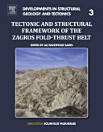Rift and Drift Episodes of Western India since the Mesozoic Era: Outcrop-Based Analyses
Nov 2025 · Developments in Structural Geology and Tectonics Book 7 · Elsevier
Ebook
688
Pages
family_home
Eligible
info
infoThis book will become available on November 1, 2025. You will not be charged until it is released.
About this ebook
Rift and Drift Episodes of Western India since the Mesozoic Era: Outcrop-Based Analyses, Volume Seven covers the architecture and tectonics of volcanic passive margin of the Indian west coast, as well as on the Deccan Large Igneous Province. Detailed understanding of tectonic evolution and stress regimes of western Indian basins is necessary to this research. As such, this book aims to provide a tectonic framework, structural history and paleostress regimes of the following rift basins of Indian western margin based on outcrop-study: (i) Jaisalmer, (ii) Bikaner- Nagaur, (iii) Barmer, (iv) Cambay and (v) Kutch. The tectonic linkage amongst these basins and with the Indian west coast will also be covered. The Mesozoic and Tertiary basins of western Indian margin have special importance in terms of their genesis and tectonic evolution. Mesozoic stratigraphy has been identified in Jaisalmer, Kutch and Barmer basins. These basins initiated as intra-cratonic rift basins during Gondwana. Episodic rifting of Africa and India resulting in separation and drifting of the Indian plate during Late Gondwana (Jurassic to Early Cretaceous), developed these basins. Inheritance of pre-existing structures played a key role in basin evolution. The Cambay and the Tertiary rifting of Barmer basin was a consequence of oblique rifting between the Seychelles micro-continent and the Indian plate, having extension direction trending ~NE. - Presents the role of pre-existing structures in rift-related fault propagation - Helps readers understand paleostress regime during different tectonic phases - Details the tectonic linkage between different basins
About the author
Swagato Dasgupta (M.Tech. Applied Geology) Senior Geologist in Reliance Industries Ltd., Navi Mumbai, INDIA. Proficient in structural geology, regional geology and seismic interpretation.Soumyajit Mukherjee is a professor in the Department of Earth Sciences at the Indian Institute of Technology Bombay, India. He received his PhD in geology and MTech in applied geology from IIT Roorkee in 2007 and 2002, respectively, and received his BSc in geology from Presidency College (Kolkata) in 1999. He was a recipient of the Hutchison Young Scientist Award from IUGS in 2004. He served as the guest researcher at the Hans Ramberg Tectonic Lab, Uppsala University, from 2005 to 2006. Dr. Mukherjee, a structural geologist and tectonician, has performed fieldwork, microstructural studies, and analogue and analytical modeling, mainly on ductile shear kinematics and collisional tectonics. His research and editorial experience spans 15 years and so far he has authored and coedited 14 books and thematic volumes.
Reading information
Smartphones and tablets
Install the Google Play Books app for Android and iPad/iPhone. It syncs automatically with your account and allows you to read online or offline wherever you are.
Laptops and computers
You can listen to audiobooks purchased on Google Play using your computer's web browser.
eReaders and other devices
To read on e-ink devices like Kobo eReaders, you'll need to download a file and transfer it to your device. Follow the detailed Help Center instructions to transfer the files to supported eReaders.







